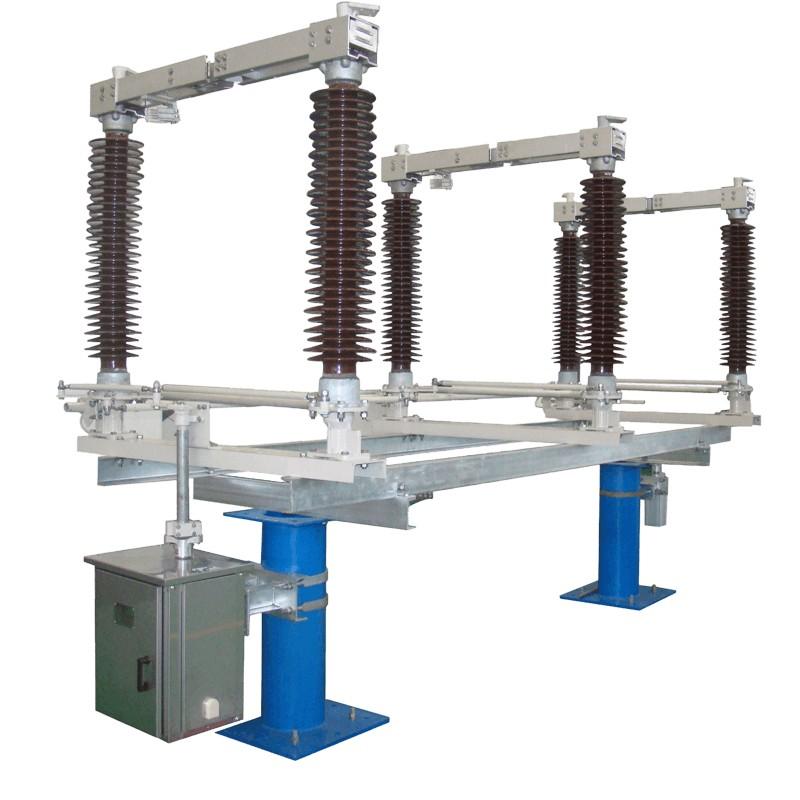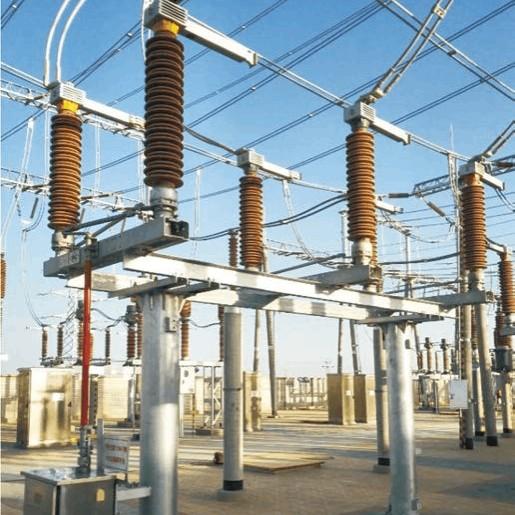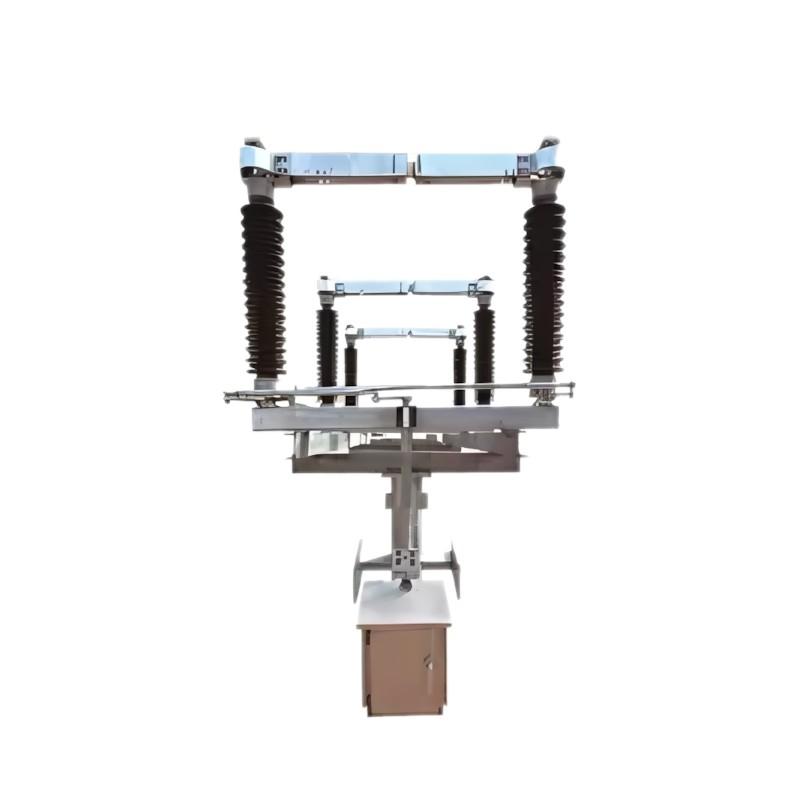1.Analysis of the Structure and Working Principle of GN30 Disconnector
The GN30 disconnector is a high-voltage switching device primarily used in indoor power systems to open and close circuits under voltage but no-load conditions. It is suitable for power systems with a rated voltage of 12 kV and AC frequency of 50 Hz or lower. The GN30 disconnector can be used either in conjunction with high-voltage switchgear or as a standalone unit. Featuring a compact structure, simple operation, and high reliability, it is widely applied in power, energy, transportation, and industrial sectors.
The structure of the GN30 disconnector mainly consists of the following components:
Fixed parts: including the base, insulators, and fixed contacts. The base supports and secures the entire switch, bearing various mechanical loads during operation. Insulators support both the fixed and rotating contacts, ensuring electrical insulation during service. The fixed contacts are connected to the power line and mounted on the base; they do not move during opening/closing operations.
Rotating parts: including the rotating (moving) contact, rotating shaft, and crank arm. The rotating contact is the active component that performs the switching action through rotation. The rotating shaft is mounted on the base and serves as the pivot for movement. The crank arm connects the rotating shaft to the operating mechanism, transmitting motion to the rotating contact to achieve opening and closing.
Operating mechanism: including manual and electric operating mechanisms. The manual mechanism features an operating handle that positions the disconnector in either the "working" or "isolated" position. Rotating the handle manually actuates the switch. An electric operating mechanism can also be installed to enable automatic remote control of switching operations.
Earthing device: The GN30 disconnector can be equipped with an earthing switch to provide grounding functionality, enhancing operational safety.
Protective devices: To ensure safe and reliable operation, protective features such as protective covers and barriers are installed to prevent accidental contact with live parts and protect personnel.
Auxiliary devices: Optional accessories like live-line indicators and fault alarm systems can be added based on user requirements to enhance intelligence, enabling real-time monitoring of operational status and timely fault detection and handling.
2.Fault Analysis of GN30 Disconnector in 10 kV Switchgear
2.1 Classification and Frequency Analysis of GN30 Disconnector Faults
As a critical high-voltage switching device, the GN30 disconnector plays an essential role in power systems. However, various faults may occur during long-term operation, affecting system reliability. To ensure safe and stable grid operation, it is necessary to classify and analyze fault frequencies to implement targeted preventive and corrective measures.
GN30 disconnector faults can be categorized as follows:
Insulation faults: The most common type, including insulator breakdown, insulation aging, and damage to insulating materials. These faults compromise insulation integrity and threaten system safety.
Contact faults: Including contact oxidation, wear, and loosening, which may cause improper opening/closing and impair circuit continuity.
Mechanical faults: Such as jamming of rotating components, crank arm fracture, or base deformation, leading to inflexible or failed operation.
Electrical faults: Including motor failure, controller malfunction, or power supply issues, which disrupt automatic switching and reduce system efficiency.
Thermal faults: Caused by inadequate heat dissipation during operation, leading to temperature rise, component deformation, aging, or even damage.
Human-induced faults: Resulting from operational errors, improper maintenance, or incorrect installation, potentially causing malfunctions or safety incidents.
To conduct fault frequency analysis, fault data over a specific period must be collected and statistically evaluated. This analysis includes:
Fault type distribution: Counting occurrences of each fault type to determine their proportion and severity.
Root cause analysis: Identifying primary causes to guide prevention strategies.
Temporal distribution: Analyzing when faults occur (e.g., time of day) to correlate with operational conditions.
Environmental correlation: Assessing links between faults and environmental factors (temperature, humidity, dust).
Operation/maintenance correlation: Evaluating how improper operation or delayed maintenance contributes to failures.
Such analysis helps identify key issues in GN30 disconnector operation, enabling targeted improvements to enhance reliability and safety.
2.2 Analysis and Discussion of Common Fault Causes
Four main causes contribute to GN30 disconnector failures:
First, design and manufacturing defects. Poor design or substandard manufacturing processes may result in insufficient structural strength, leading to part fracture or deformation. Inappropriate material selection—such as insulation materials lacking wear or heat resistance—also increases failure risk.
Second, overload and overvoltage conditions. Prolonged overload causes excessive heating, leading to thermal expansion or insulation aging, impairing switching and isolation functions. Overvoltage events (e.g., lightning strikes or grid surges) can cause insulation breakdown or arcing.
Third, improper operation. Operator errors—such as operating without de-energizing, excessive handle force causing mechanical damage, or neglecting maintenance (e.g., failing to clean or lubricate)—can trigger faults.
Fourth, environmental and natural factors. Extreme cold may cause motor failure due to moisture condensation or freezing. High temperatures accelerate insulation aging and thermal expansion. Natural disasters like earthquakes can physically damage or deform the switch.
3.Improvement Methods for GN30 Disconnector Faults in 10 kV Switchgear
3.1 Improvements in Design and Manufacturing
Material selection is critical to performance and reliability. High-strength, wear-resistant materials should be used for fixed and rotating contacts to withstand high voltage and frequent operations. Insulation materials must offer excellent dielectric strength and thermal resistance.
Precision manufacturing processes ensure dimensional accuracy and assembly quality. Strict control of machining tolerances prevents fit issues or operational inefficiencies.
During design, reliability analysis should consider potential stressors—voltage surges, arcing, localized overheating—to identify and mitigate failure risks.
Rigorous quality inspection and testing throughout production—including raw material checks, component verification, and pre-assembly reviews—are essential. Tests should cover mechanical strength, electrical performance, insulation integrity, and operational smoothness.
Manufacturers should establish comprehensive quality management systems, including quality control protocols, process instructions, and inspection standards, to standardize production, improve efficiency, and reduce fault rates.
3.2 Measures to Prevent Overload and Overvoltage
For overload-related issues (e.g., contact overheating, insulator expansion), immediately disconnect power, assess load conditions, and redistribute power to avoid recurrence. If load cannot be reduced, deploy backup equipment or alternative power sources.
For overvoltage events (e.g., insulation breakdown, arcing), disconnect power and inspect insulation and component withstand capability. Replace degraded insulation or aged components promptly. Install overvoltage protection devices such as zinc oxide surge arresters to shield the disconnector from voltage spikes.
3.3 Improved Operational Procedures
Operators must thoroughly understand the manual, grasp working principles, and follow correct procedures. Always verify de-energization before operation to prevent accidents.
Maintenance personnel should perform regular cleaning, lubrication, and inspections. Cleaning removes dust and contaminants to maintain insulation stability. Lubrication reduces friction for smooth operation. Inspections detect early signs of wear or damage.
Conduct periodic checks and tests—including contact wear, insulator condition, mechanism function, and electrical performance—to verify compliance with design specifications and preempt major failures.
3.4 Prevention and Control of Environmental Factors
Installing protective enclosures effectively shields internal components from dust, rain, debris, and contamination, preserving insulation performance. Enclosures must be designed to allow operation and maintenance access.
In low-temperature environments, use insulation materials with verified cold-resistance to maintain mechanical and electrical properties and prevent brittleness.
Under harsh conditions, regularly inspect insulators, insulation structures, and electrical components. Perform insulation resistance and electrical performance tests as needed to detect and address issues early.
4.Conclusion
This paper conducts an in-depth analysis of common failure causes of the GN30 disconnector in 10 kV switchgear and proposes a series of improvement measures aimed at enhancing its reliability and safety to ensure stable power system operation. Future research could explore additional influencing factors and more effective mitigation strategies. Furthermore, practical case studies could validate the effectiveness of these methods, providing richer theoretical support for the reliable operation of power systems.


























